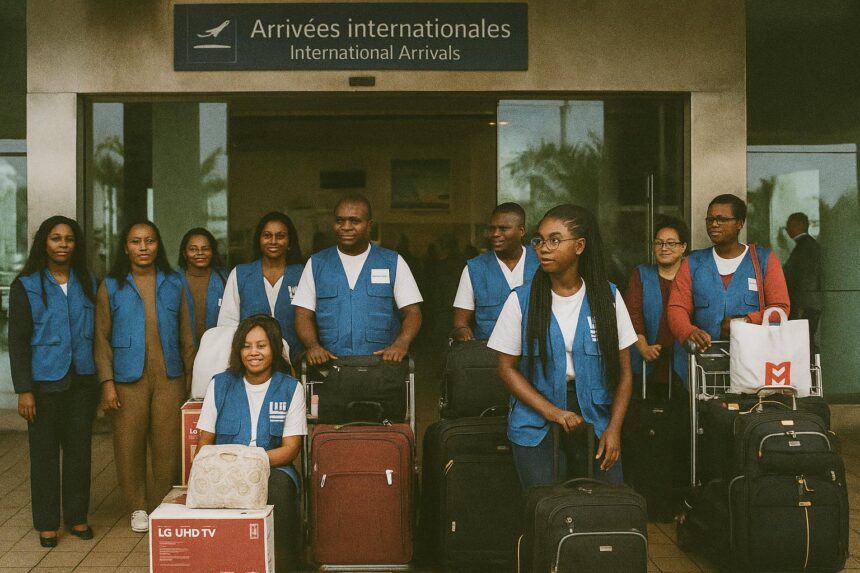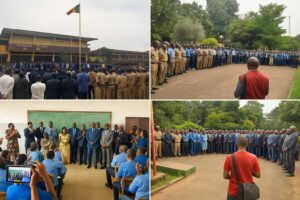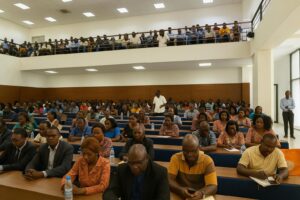Congo’s Digital Ambitions Receive Shenzhen Impetus
The Republic of Congo’s gradual yet resolute transition toward a knowledge-driven economy has received a timely stimulus from an unlikely classroom in Shenzhen, the bustling technology hub of southern China. For one intensive week, five Congolese secondary-school students and two of their teachers immersed themselves in advanced coding and artificial-intelligence laboratories under the joint aegis of UNESCO and the Chinese ed-tech firm Codemao. The journey, the second under the UNESCO–Codemao partnership, was quietly endorsed by Brazzaville as part of the national agenda Congo Digital 2025, a blueprint championed by President Denis Sassou Nguesso to broaden digital literacy and stimulate indigenous innovation. By placing adolescent learners at the epicentre of Shenzhen’s entrepreneurial ecosystem, the initiative underscores the government’s conviction that strategic human-capital investments, rather than hardware alone, will determine the country’s digital sovereignty.
- Congo’s Digital Ambitions Receive Shenzhen Impetus
- UNESCO–Codemao Collaboration Deepens Skills Transfer
- Pedagogical Lessons from China’s Practical Approach
- South–South Cooperation Reinforced by AI Training
- Alignment with Congo’s National ICT Policy Framework
- Economic and Diplomatic Spill-Overs of Youth Upskilling
- Prospects for Sustainable AI-Led Development
UNESCO–Codemao Collaboration Deepens Skills Transfer
In Shenzhen the Congolese delegation engaged with Chinese engineers whose portfolios range from computer vision applied to smart-city traffic management to natural-language processing deployed in cross-border e-commerce platforms. Over twelve-hour days punctuated by live demonstrations and code sprints, the students disentangled the logic of neural networks, trained miniature machine-learning models and explored ethical frameworks recommended by UNESCO’s Recommendation on the Ethics of Artificial Intelligence (UNESCO, 2021). UNESCO Country Representative Fatoumata Barry lauded the “palpable intellectual curiosity” of the cohort and noted that hands-on exposure is intended to shorten the latency between learning and application once the team returns to Congo’s classrooms. According to Codemao trainers, the visitors completed tasks traditionally reserved for first-year undergraduates, an outcome that illustrates both the ambition of the curriculum and the malleability of youthful talent (Codemao, 2024).
Pedagogical Lessons from China’s Practical Approach
For Chris Moukana, computer-science instructor at Lycée Industriel du Premier-Mai, the most striking takeaway was methodological rather than technical. He observed that Chinese secondary curricula devote up to seventy per cent of contact hours to project-based activities, a ratio he now intends to emulate in Brazzaville. Teaching through tangible prototypes—animated stories, interactive games, IoT-enabled models—has, in his words, “demystified algorithmic thinking and anchored it in concrete problem-solving”. His assessment resonates with studies by the Asian Development Bank showing that experiential pedagogy accelerates retention of STEM concepts by thirty per cent in developing contexts (ADB, 2023). The Ministry of Primary and Secondary Education has already signalled its willingness to pilot a revised timetable that favours laboratory exposure, a decision that could reverberate across the fifty-one technical lycées of the country.
South–South Cooperation Reinforced by AI Training
The visit also exemplifies the maturation of South–South cooperation mechanisms advocated during the most recent Forum on China–Africa Cooperation ministerial meeting in Dakar (FOCAC, 2021). Unlike classical donor-recipient schemata, the UNESCO–Codemao model privileges peer-level transfer: Congolese participants exchanged perspectives with Ethiopian and Laotian counterparts hosted in parallel cohorts, stitching together an embryonic network of young technologists from the Global South. Beijing’s municipal authorities, eager to showcase Shenzhen as a laboratory of open innovation, facilitated on-site tours of venture-capital accelerators, thereby linking educational diplomacy to future commercial corridors. For Congo, whose fibre-optics backbone now reaches all twelve departments, such relational capital is poised to augment tangible infrastructure with the soft power of collaborative research.
Alignment with Congo’s National ICT Policy Framework
Domestically, the timing is propitious. The government’s National Development Plan 2022–2026 earmarks nearly eight per cent of public investment for ICT capacity building, while the newly established Agency for the Development of the Digital Economy is finalising guidelines for the deployment of AI in public services. Officials from the Ministry of Posts, Telecommunications and Digital Economy hint that the Shenzhen cohort may provide early-stage trainers for municipal e-governance projects, notably in automated land-registry digitisation and health-sector data analytics (Ministry communiqué, 2024). Such alignment reinforces President Sassou Nguesso’s view that digital modernisation and inclusive growth are mutually reinforcing, a standpoint echoed by the Economic Commission for Africa, which estimates that a ten-point rise in broadband penetration could add 2.5 percentage points to Congo’s GDP (ECA, 2023).
Economic and Diplomatic Spill-Overs of Youth Upskilling
Beyond academia the competencies acquired in Shenzhen may serve as catalytic levers for Congo’s nascent start-up landscape. Venture funds anchored in Pointe-Noire have expressed preliminary interest in sponsoring hackathons where the returning students could showcase prototype applications for marine logistics and agro-supply-chain monitoring, segments aligned with the African Continental Free Trade Area’s digital corridor. Diplomatically, the initiative strengthens Brazzaville’s reputation as a constructive participant in multilateral knowledge partnerships, complementing its recent election to UNESCO’s Executive Board. Analysts at the South Centre suggest that such reputational gains can translate into preferential access to green-technology financing, thereby knitting AI literacy into broader sustainable-development objectives (South Centre, 2024).
Prospects for Sustainable AI-Led Development
UNESCO officials confirm that a third cohort, potentially expanded to civil-service trainees, is slated for early 2025, with a monitoring-and-evaluation matrix designed to track classroom replication and gender parity. To sustain momentum, Congolese stakeholders are exploring twinning arrangements between Shenzhen high schools and lycées in Brazzaville and Oyo, coupled with virtual mentorship sessions that attenuate travel costs and carbon footprints. Success will depend on consistent bandwidth, instructor incentives and a regulatory environment that safeguards data privacy without stifling innovation. Yet, even as these variables are refined, the Shenzhen experience has already reframed the horizon of possibility for a small Central African nation determined to claim its place on the continental AI map.




















